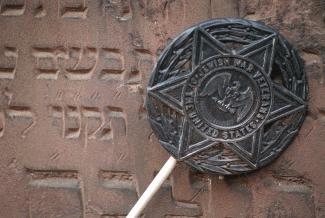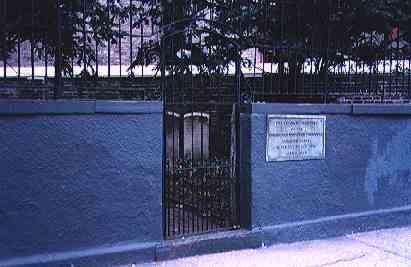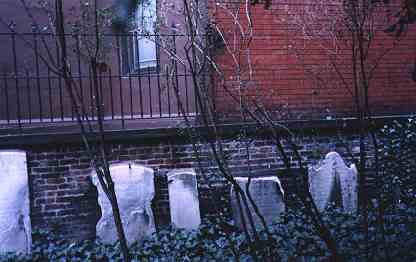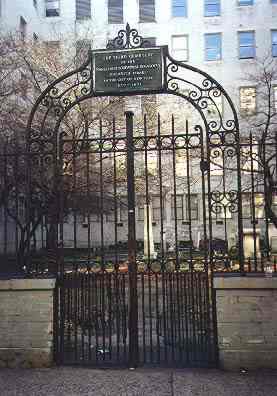
Cemeteries of Congregation Shearith Israel - The Spanish and Portuguese Synagogue
Shearith Israel was the only Jewish congregation in New York City from 1654 until 1825. During this entire span of history, all of the Jews of New York belonged to the congregation. Shearith Israel was founded by 23 Jews, mostly of Spanish and Portuguese origin. The earliest Jewish cemetery in the U.S. was recorded in 1656 in New Amsterdam where authorities granted the Shearith Israel Congregation "a little hook of land situated outside of this city for a burial place." Its exact location is now unknown. The Congregation's "second" cemetery, which is today known as the FIRST cemetery because it is the oldest surviving one, was purchased in 1683.
55 St. James Place, opposite Chatham Square, in use 1682-1828
76 W. 11th, between 6th and 7th Avenue, in use 1805-1829
21st Street between 6th and 7th Avenues, in use 1829-1851
 |
First Cemetery at St. James Place just off Chatham Square in what is today Chinatown. This cemetery dates to 1683. Harmon Goldstone fought to get the cemetery its rightful place on the National Register of U.S. Historic Places #80002689 |
 |
A marker denotes the gravesite of a Jewish Revolutionary War veteran at Congregation Shearith Israel's first cemetery. |
 |
Second Cemetery: West 11th Street just east of 6th Avenue (Greenwich Village) |
 |
"New
Bowery Cemetery " The Second Cemetery: This cemetery is much smaller
than it originally was. Burials began here in 1805, in what was a much
larger, square plot extending into what is now the street. The Commissioners'
Plan had established the city's grid in 1811, but not until 1830 was West
11th Street cut through, at that time reducing the cemetery to its present
tiny triangle. The disturbed plots were moved further uptown to the Third
Cemetery [below] on West 21st Street. In 1852 city law forbade burial
within Manhattan, and subsequent interments have been made in Queens.*
|
 |
98-110 West 21st Street [in use 1829-1851] The cemetery is between loft buildings and across the street from the School Of Visual Arts on West 21st St just off 6th Avenue is the Third Cemetery. This cemetery was adjacent to the congregation's synagogue on 19th Street--built in 1860 and now long gone. |
Today Shearith Israel has a Cemetery in Glendale, Queens, New York
| "There remain two cemeteries to visit, built by descendants of the first Portuguese Jews. One of these is the tiny triangle with twenty headstones familiar to Greenwich Villagers, on Eleventh Street, east of Sixth Avenue. The cemetery of those who died by plagues, particularly the dread yellow fever of 1798, it once covered many acres. The second, on Twenty-first Street, west of Sixth, has perhaps a hundred and fifty tombstones. Burials were made here as late as 1851, although it was against the law then, and several of the bereaved families had to pay a fine of two hundred and fifty dollars. The Portuguese Jews formed the Congregation Shearith Israel whose present congregation - their synagogue is at 99 Central Park West - has repeatedly rejected offers of hundreds of thousands for the Twenty-first Street site. Once a department store wanted to arch a building over the cemetery, leaving it undisturbed, but that plan was rejected, too." -- (The New Yorker "Where Time Has Stopped," 25 February 1928) |
Congregation records available, 1706-1949. 8 reels microfilm. Collection includes microfilm copy of constitution and by-laws, minutes, and financial records. Available through Hebrew Union College - Jewish Institute of Religion
* According to legend, the location of the red-bricked building abutting the cemetery has an unusual history of its own. On the site of that building, there was a Civil war tavern known as the "Grapevine". Many Union officers went there including many southern spies, and many incognito newspaper reporters.
Of course everyone knew that everyone else was eavesdropping on conversations there, so the tavern became known as the place where many rumors originated. This became the origin of the phrase "heard it through the grapevine"! The newspapers began using this phrase which is in common use now, and later it made Gladys Knight and Marvin Gaye a lot of money. Source: Willensky and White's AIA Guide to New York City